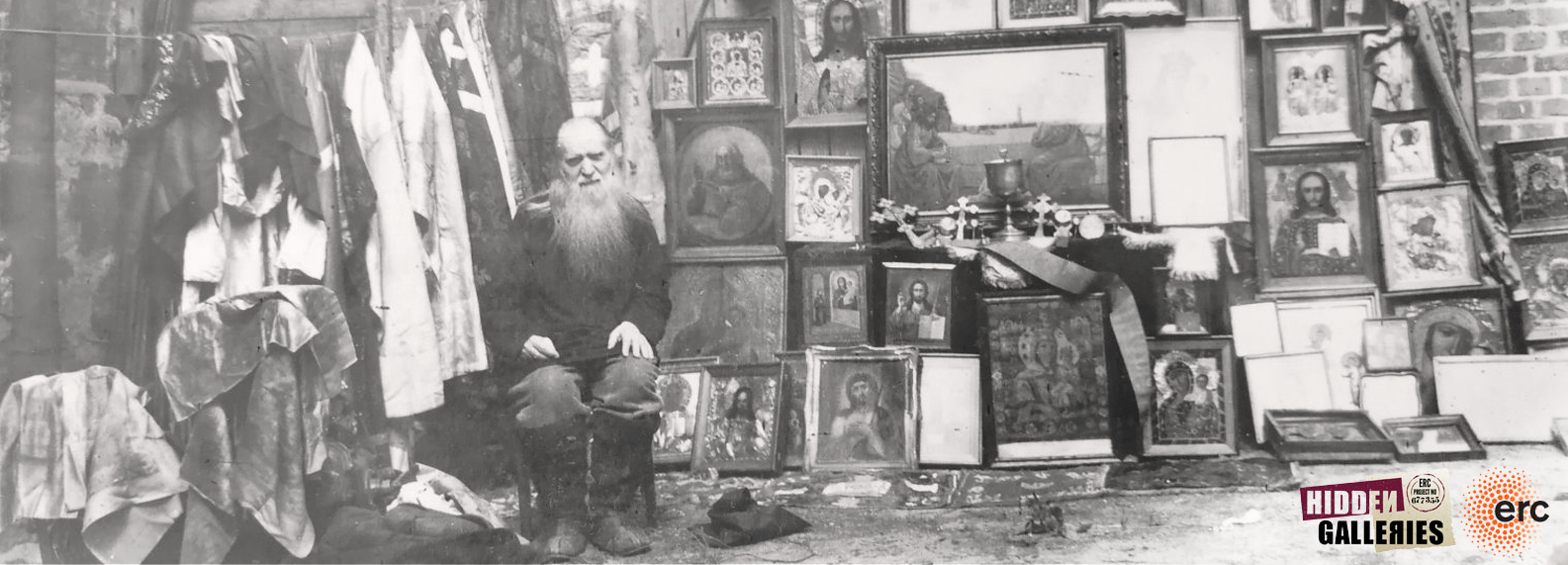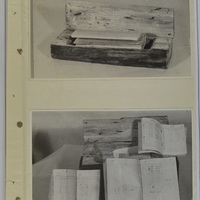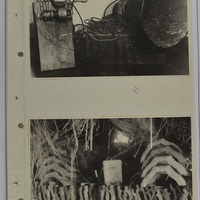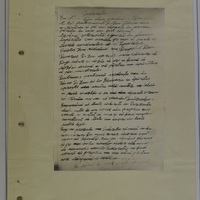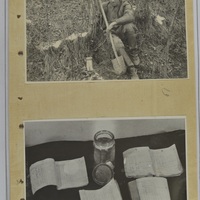Crime scene photographs from a file on Jehovah’s Witnesses in Romania
Item
Title
Crime scene photographs from a file on Jehovah’s Witnesses in Romania
Bűnügyi helyszíni fotók a romániai Jehova Tanúi egyház titkosrendőrségi aktájából
Description
These crime scene photographs were selected from a documentary file on Jehovah’s Witnesses in the former administrative unit called Cluj region. The pictures were taken during various house searches conducted by the secret police in the homes of Jehovah’s Witnesses or people related to them. The photos in the first image show a "normal sized piece of firewood" with its inside carved out and the reports of the Huedin circuit (territorial unit within the Jehovah's Witnesses organisation) from 1951–1954 that were hidden inside it. It was found in the home of the already arrested Huedin circuit servant (leader of the circuit responsible for coordinating congregation work within his unit). The first photo on the second image shows a loudspeaker and accessories. The loudspeaker was found in the well of the arrested assistant of the Huedin circuit servant, while other parts of the equipment were hidden piece by piece underneath the pigsty. According to the report, the loudspeaker was used during meetings. In the second photo in this image we can see a coded report from the same circuit hidden amongst unused tiles. The third image is a statement about refusing military service. It was written by one of the pioneers (evangelisers actively taking part in the life of the congregations) who was also arrested by the time of the report. According to the secret police, the statement was distributed as a sample amongst young male members. The top picture on the fourth image portrays the arrested leader of the Abrud circuit seated beside a glass jar containing coded reports. The picture intends to capture the moment when the jar was dug up from its concealment, near the roots of a tree. The photo below offers a close-up of the material contained in the jar.
The photos follow the common standards of crime scene photography of Eastern European secret services. These photos were often “re-enactments”, a common method to illustrate the crime and incriminate its perpetrator; the fourth image is an excellent example of this. All pictures were supplemented by detailed captions providing basic information about the items shown and the place they were found. The report included in the file emphasised that Jehovah’s Witnesses were exceptionally resourceful when it came to concealing “forbidden” materials, so much so that the services needed tips from their informers to find them. The photos in this file were used to support accusations (participating in a conspiratory and hostile organisation, producing and disseminating forbidden publications, encouraging young men to refuse military service, holding clandestine meetings etc.) against arrested members and helped authorities to convict them.
Up to 1990, apart from two short periods between 1933–1937 and 1945–1949, Jehovah’s Witnesses did not enjoy legal recognition in Romania. They suffered intense persecution at the hands of interwar democratic governments as well as the wartime and post-war totalitarian regimes. The main reasons given for their repression were their proselytising activity, the lack of transparency in their organisation, their refusal to perform military service or participate in elections and other civic duties, their ties to their American headquarters, and their heralding of the end of regime and the onset of a theocratic kingdom. Throughout communism, Jehovah’s Witnesses were closely surveilled by the Securitate with many being imprisoned or sent to labour camps. In spite of the repressive environment, however, their number grew from 15000 in 1949 to 35000 in 1990.
These images come from file CNSAS D 014428. Beside these images it contains several other crime scene or evidence photographs of various hidden materials (a typewriter, fake IDs, religious brochures, coded reports), a 17-page report and the network scheme of the groups active in the region.
For further readings on Jehovah’s Witnesses and the Romanian state see:
Pintilescu, Corneliu – Fătu-Tutoveanu, Andrada, 2011, Jehova’s Witnesses in Post-communist Romania: the Relationship Between the Religious Minority and the State (1989-2010). Journal for the Study of Religions and Ideologies, vol. 10, issue 30 (Winter): 102–126.
For related entries see:
The photos follow the common standards of crime scene photography of Eastern European secret services. These photos were often “re-enactments”, a common method to illustrate the crime and incriminate its perpetrator; the fourth image is an excellent example of this. All pictures were supplemented by detailed captions providing basic information about the items shown and the place they were found. The report included in the file emphasised that Jehovah’s Witnesses were exceptionally resourceful when it came to concealing “forbidden” materials, so much so that the services needed tips from their informers to find them. The photos in this file were used to support accusations (participating in a conspiratory and hostile organisation, producing and disseminating forbidden publications, encouraging young men to refuse military service, holding clandestine meetings etc.) against arrested members and helped authorities to convict them.
Up to 1990, apart from two short periods between 1933–1937 and 1945–1949, Jehovah’s Witnesses did not enjoy legal recognition in Romania. They suffered intense persecution at the hands of interwar democratic governments as well as the wartime and post-war totalitarian regimes. The main reasons given for their repression were their proselytising activity, the lack of transparency in their organisation, their refusal to perform military service or participate in elections and other civic duties, their ties to their American headquarters, and their heralding of the end of regime and the onset of a theocratic kingdom. Throughout communism, Jehovah’s Witnesses were closely surveilled by the Securitate with many being imprisoned or sent to labour camps. In spite of the repressive environment, however, their number grew from 15000 in 1949 to 35000 in 1990.
These images come from file CNSAS D 014428. Beside these images it contains several other crime scene or evidence photographs of various hidden materials (a typewriter, fake IDs, religious brochures, coded reports), a 17-page report and the network scheme of the groups active in the region.
For further readings on Jehovah’s Witnesses and the Romanian state see:
Pintilescu, Corneliu – Fătu-Tutoveanu, Andrada, 2011, Jehova’s Witnesses in Post-communist Romania: the Relationship Between the Religious Minority and the State (1989-2010). Journal for the Study of Religions and Ideologies, vol. 10, issue 30 (Winter): 102–126.
For related entries see:
Az itt látható helyszíni fotók az 1950 és 1968 között létező kolozsi régióban élő Jehova Tanúinak titkosszolgálati dossziájából származnak. A képek a Tanúk vagy velük kapcsolatban álló emberek otthonaiban tartott házkutatások során készültek. Az elsőképen látható fényképek egy kivájt belsejű „szokásos méretű tűzifa darabot” ábrázolnak, amelybe a szervezet bánffihunyadi körzetének 1951 és 1954 között írott jelentéseit rejtették (alsó kép). A fadarab a már korábban letartóztatott bánffyhunyadi körzetfelvigyázó otthonából került elő (a körzetfelvigyázók a körzetükben működő gyülekezetek munkáját szervezték). A második kép első fotóján egy hangszóró látható, a hozzá tartozó alkatrészekkel együtt. Az eszközt a bánffihunyadi felvigyázó szintén letartóztatott segédjének házánál egy kútban találták meg, az alkatrészeit pedig a disznóól alatt. A jelentés szerint a hangszórót a gyülekezeti találkozókon használták. A második fényképen a körzet egyik, tetőcserepek közé rejtett kódolt jeletnését láthatjuk. A harmadik képen egy, a katonai szolgálatot elutasító nyilatkozat olvasható, egy addigra már szintén letartóztatott úttörő (azaz a gyülekezetek életében aktívan résztvevő hittérítő) kézírásával; a titkosrendőrség szerint ezt mintaként osztogatták a gyülekezet fiatal férfitagjai között. A negyedik kép legfelső fotóján az abrudbányai körzet letartóztatott vezetője ül egy kódolt jelentésekkel teli befőttesüveg mellett. A fotó azt a pillanatot próbálja megörökíteni, amikor a befőttesüveget egy fa gyökerei között megtalálják. Az alsó kép a befőttesüveg tartalmát mutatja meg közelről.
A fényképek a kelet-európai titkosszolgálatoknál bevett helyszíni fotók jellegzetes jegyeit mutatják. A bűntett bizonyításához gyakran újrajátszatták az eseményeket a vádlottakkal; ez történt például a negyedik kép esetében is. A fényképeket minden esetben részletes leírással látták el, amelyben röviden ismertették az ábázolt tárgyat és megtalálásának helyét. A dossziéban olvasható jelentésben külön is kihangsúlyozták, hogy a Jehova Tanúi különösen ravasznak és találékonynak bizonyultak, ha tiltott tárgyak elrejtéséről volt szó, olyannyira, hogy a titkosrendőrség csakis az ügynököktől kapott fülesek alapján tudta a rejtekhelyeket fellelni. A dossziéban közölt képeket a büntetőeljárás során bizonyítékul használták a Tanúk ellen felhozott vádakban (a rendszerrel ellenséges, konspiratív szervzetben való részvétel, rendszerellenes kiadványok előállítása és terjesztése, a katonai szolgálat megtagadásának bátorítása, titkos találkozókon való részvétel, stb.).
1990 előtt – két rövid, 1933–1937 és 1945–1949 közötti időszakot leszámítva – a Jehova Tanúi mozgalom Romániában nem volt törvényileg elismert egyház; hittérítő tevékenysége, a szervezet átláthatatlansága, amerikai kötődése, a katonai szolgálat és a választáson való részvétel megtagadása, valamint rendszerellenesnek tekintett próféciái miatt ki volt téve a hatóságok üldözésének mind a két világháború között, mind pedig a háború alatti és az azt követő totalitáriánus rendszerekben. A kommunista időszakban a szervezet tagjait a titkosszolgálatok folyamatosan megfigyelték, sokukat börtönbe vetették vagy munkatáborba küldték. Az üldöztetés és elnyomás ellenére a Tanúk száma 1949 és 1990 között 15000 főről 35000 főre nőtt.
Ezek a képek a CNSAS D 014428 dossziéból származnak, amely egyéb helyszíni fotókat (hamis személyi igazolványokról, vallásos kiadványokról, kódolt jelentésekről, elrejtett írógépről) és egy, a szervezetről struktúrájáról készült hálózati ábrát is tartalmaz.
A Jehova Tanúinak romániai helyzetéről lásd:
Pintilescu, Corneliu – Fătu-Tutoveanu, Andrada, 2011, Jehova’s Witnesses in Post-communist Romania: the Relationship Between the Religious Minority and the State (1989-2010). Journal for the Study of Religions and Ideologies, vol. 10, issue 30 (Winter): 102–126.
A fényképek a kelet-európai titkosszolgálatoknál bevett helyszíni fotók jellegzetes jegyeit mutatják. A bűntett bizonyításához gyakran újrajátszatták az eseményeket a vádlottakkal; ez történt például a negyedik kép esetében is. A fényképeket minden esetben részletes leírással látták el, amelyben röviden ismertették az ábázolt tárgyat és megtalálásának helyét. A dossziéban olvasható jelentésben külön is kihangsúlyozták, hogy a Jehova Tanúi különösen ravasznak és találékonynak bizonyultak, ha tiltott tárgyak elrejtéséről volt szó, olyannyira, hogy a titkosrendőrség csakis az ügynököktől kapott fülesek alapján tudta a rejtekhelyeket fellelni. A dossziéban közölt képeket a büntetőeljárás során bizonyítékul használták a Tanúk ellen felhozott vádakban (a rendszerrel ellenséges, konspiratív szervzetben való részvétel, rendszerellenes kiadványok előállítása és terjesztése, a katonai szolgálat megtagadásának bátorítása, titkos találkozókon való részvétel, stb.).
1990 előtt – két rövid, 1933–1937 és 1945–1949 közötti időszakot leszámítva – a Jehova Tanúi mozgalom Romániában nem volt törvényileg elismert egyház; hittérítő tevékenysége, a szervezet átláthatatlansága, amerikai kötődése, a katonai szolgálat és a választáson való részvétel megtagadása, valamint rendszerellenesnek tekintett próféciái miatt ki volt téve a hatóságok üldözésének mind a két világháború között, mind pedig a háború alatti és az azt követő totalitáriánus rendszerekben. A kommunista időszakban a szervezet tagjait a titkosszolgálatok folyamatosan megfigyelték, sokukat börtönbe vetették vagy munkatáborba küldték. Az üldöztetés és elnyomás ellenére a Tanúk száma 1949 és 1990 között 15000 főről 35000 főre nőtt.
Ezek a képek a CNSAS D 014428 dossziéból származnak, amely egyéb helyszíni fotókat (hamis személyi igazolványokról, vallásos kiadványokról, kódolt jelentésekről, elrejtett írógépről) és egy, a szervezetről struktúrájáról készült hálózati ábrát is tartalmaz.
A Jehova Tanúinak romániai helyzetéről lásd:
Pintilescu, Corneliu – Fătu-Tutoveanu, Andrada, 2011, Jehova’s Witnesses in Post-communist Romania: the Relationship Between the Religious Minority and the State (1989-2010). Journal for the Study of Religions and Ideologies, vol. 10, issue 30 (Winter): 102–126.
Kapcsolódó bejegyzések:
Subject
Communism and Christianity
Communism and Christianity--Europe, Eastern
Communism--Europe--History--20th century
Communism--Europe, Eastern--History--20th century
Secret police (secret service)
Surveillance
Totalitarianism
Material culture--Religious aspects
Religious sects
Sects
Communism--Romania--History--20th century
Confiscations
Evidence photographs
Evidence, criminal
Millenialism
Romania. Securitatea
Surveillance detection
Creator
Agnes Hesz
Source
Consiliul Național pentru Studierea Arhivelor Securității
CNSAS D 014428
http://www.cnsas.ro
CNSAS D 014428
http://www.cnsas.ro
Publisher
This project has received funding from the European Research Council (ERC) under the European Union’s Horizon 2020 research and innovation programme No. 677355
Date
1955
Rights
copyright for these images belongs to CNSAS
http://www.cnsas.ro
http://www.cnsas.ro
Format
jpg
Language
Ro
Type
image
Identifier
CNSAS D 014428
http://www.cnsas.ro
http://www.cnsas.ro
Coverage
20th century
Romania
Romania
Bibliographic Citation
Agnes Hesz, "Crime scene photographs from a file on Jehovah’s Witnesses in Romania,"
Date Created
2019
